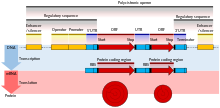Operon
An operon is a functional unit of the DNA of prokaryotes and some eukaryotes as well as organelles derived from bacteria such as the plastids (see endosymbiont theory ).
The functional unit of an operon consists of a promoter , operator (s) and several (structural) genes that code for proteins with typically related functions. Depending on the operon, various regulatory proteins can interact with the operators as repressors or as activators and thereby switch the transcription of the genes in the operon on or off. This in turn depends on interactions with substances formed or absorbed by the cell (ligands or effector molecules). As a result, the synthesis of the relevant mRNA (messenger RNA) can be activated or inhibited, indirectly also the translation of the encoded proteins.

All genes of an operon are controlled in a coordinated manner. The operon model of gene regulation was developed in 1960 by the French scientists François Jacob and Jacques Monod et al. a. developed on the basis of the lac operon of E. coli and later expanded. For their work in this field they received the 1965 Nobel Prize in Physiology or Medicine .
Operons also play an important role as tools of genetic engineering. Any genes can be placed under the control of the regulatory elements of an operon and can thus, for. B. in the case of the lac operon by adding the synthetic inducer IPTG ( isopropyl-β-D-thiogalactopyranoside ), specifically activated.
Examples are the lac operon , the trp operon and the ara operon .
literature
- Nancy Trun, Janine Trempy: Gene expression and regulation. In: Nancy Trun, Janine Trempy: Fundamental Bacterial Genetics. Blackwell, Malden MA et al. 2004, ISBN 0-632-04448-9 , pp. 191-212, online (PDF; 500 kB) .
Web links
- Animated operon on Holger Schickor's homepage
Individual evidence
- ^ Miller JH, Suzuki DT, Griffiths AJF, Lewontin RC, Wessler SR, Gelbart WM: Introduction to genetic analysis , 8th. Edition, WH Freeman, San Francisco 2005, ISBN 0-7167-4939-4 , p. 740.
- ↑ Jacob, F., Perrin, D., Sanchez, C. & J. Monod (1960): L'opéron: groupe de gènes à expression coordonnée par un operator. In: CR Hebd Seances Acad Sci. Vol. 250, pp. 1727-1729. PMID 14406329
- ↑ F. Jacob & J. Monod (1961): Genetic regulatory mechanisms in the synthesis of proteins. In: J. Mol. Biol. Vol. 3, pp. 318-356. PMID 13718526
- ^ FO Jacob : The Birth of the Operon . In: Science . 332, No. 6031, 2011, pp. 767-767. doi : 10.1126 / science.1207943 . PMID 21566161 .
- ^ Information from the Nobel Foundation on the 1965 award ceremony to Francois Jacob and Jacques Monod (English).
